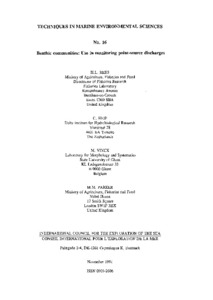| dc.description.abstract | The response to a request from the ICES Advisory Committee on Marine Pollution (ACMP) for advice on this topic has been structured along the following lines:
Section A - a general review of benthic studies in relation to pollution. This was felt to be important in view of increasing interest in the application of a variety of biological effects techniques, as benthic communities represent only one of many possible targets in the study of the effects of point-source discharges. The account also addresses the issues raised concerning the nature and significance of observed responses;
Section B - guidelines for the conduct of benthic monitoring programmes around point-source discharges;
Section C - examples of effective survey design; and
Section D - a review of the use of meiofauna in pollution studies; this is a relatively new area of application, and was felt to warrant separate treatment.
The benthic biota possess a number of important attributes which justify their inclusion in the majority of marine monitoring programmes concerned with biological impact. For example, they are intimately associated with the seabed for much for their life-cycle; this environment is an appropriate target, because sediments act as the ultimate sink for most contaminants dis- charged into the sea. Added to this, their relative immobility (and consequent comparative ease of quantitative sampling), and long life span (commonly exceeding one year) requires that they must adapt to repeated additions of waste inputs.
The monitoring of benthic communities, especially over several years, represents the most suitable direct method presently available for assessing changes in coastal marine ecosystems. However, the application of alternative measures of impact at a variety of levels of biological organisation deserves continuing encouragement, because no single measure has yet been devised which can be used to predict effects on the marine ecosystem as a whole. Such measures should, as far as possible, be integrated with field studies of benthic communities.
Assessments as to the wider significance of benthic changes may embrace aesthetic and conservation interests, as well as those relating to fishery resources. Clearly, the science of benthic ecology cannot in isolation address all these matters, but it can make a valuable contribution to the decision-making process. For example, many studies show that effects on the benthos are not widespread, but are confined near to inputs. Such 'negative' findings, which may be unap- pealing as a scientific outcome, do much to assuage concern over the wider impact of controlled waste disposal to sea, in as much as a limited change in a benthic community implies a similarly limited change in dependent biota, such as demersal fish. However, important gaps still remain in our general understanding of the interactions of benthic communities with other ecosystem components, and improvements in this area would heighten confidence in predictions of the consequences of benthic changes.
The types of benthic community responses presently suitable for the measurement of impact have been identified, along with those having future potential but requiring further methodological research. The precise and accurate measurement of such responses is governed by decisions regarding the type of equipment to use, the number of replicates, and the sampling design. These are invariably site-specific and, as a result, the account provides detailed guidance, but not a general 'blue-print', for the conduct of benthic surveys around point-source discharges.
Close attention to field sampling strategy is, therefore, critical to the success of monitoring programmes; this is underscored by the fact that most of the cost attached to benthic surveys occurs at the stage of sampling and (with the added constraint of time) in the laboratory analysis of these samples. Such cost limitations do not generally apply to data analysis, especially given the wide availability of computers and tailored software, so that the application of a range of complementary measures of data structure could be recommended. | en_US |
 Repository of community practices in Ocean Research, Applications and Data/Information Management
Repository of community practices in Ocean Research, Applications and Data/Information Management
